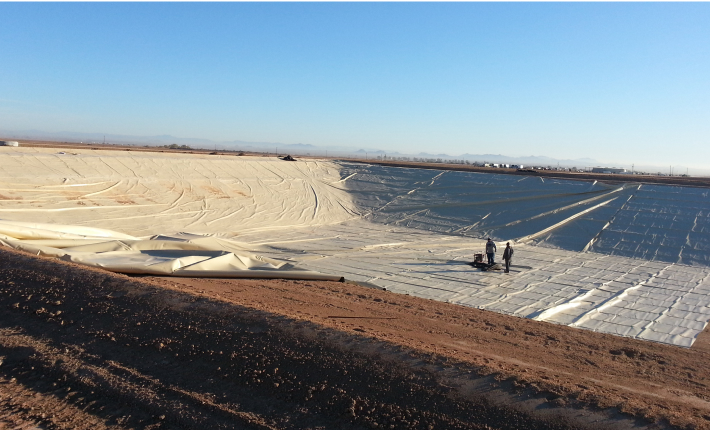The function of large pond liners for commercial ponds calls for sophisticated liner materials, and this becomes increasingly important the larger the pond and the more exacting the ground conditions.
While the small garden fish pond will often turn to the common retail offering of the synthetic rubber EPDM, there are frequently better choices available, notably reinforced polyethylene (RPE). RPE possesses better qualities and offers greater advantages than EPDM, including a much lower cost.
RPE is generally lighter and stronger than EPDM, as well as costing less. At as low as one-third the cost of the most popular 45-mil EPDM retail product, the Aqua Series 30-mil RPE from Western Environmental Liner offers proven greater strength and puncture resistance for a far lighter weight compared with other liner materials.
Commercial Pond Liner Cost and Handling
EPDM is not known for strength, despite its good qualities for weathering, sunlight resistance, temperature and chemical resistance, all of which have made it valuable in automotive and roofing applications. But strength and tear-resistance matter if the ground is liable to shift or snag a liner, inducing punctures or tears. RPE is lighter weight yet with greater strength and puncture resistance, and comes in larger sized sheets, while also having equal or greater resistance to chemicals, sunlight and weather deterioration. Both materials are non-toxic for fish ponds, or even potable water situations.
Weight becomes increasingly important the larger the project. The pond liner material has to be shipped, unloaded and handled into place, and covering a large area with the lightest and most flexible choice of material makes economic and engineering sense.
The largest retail panel of EPDM typically available is a 50′ x 80′ sheet, 4,000 square feet priced at around 75 cents per square foot. By contrast, Western Liner’s Aqua Series RPE sheets typically ship at 150′ x 150′, a flat coverage of 22,500 square feet, and can be two to three times more affordable.
Western Liner’s three factories can produce sheets as large as 350′ x 350′ – which weighs around 14,000 pounds, so shipping and handling costs and methods need to be factored into project planning. As always, get the free consultation before making fixed plans.
All pond liners can be joined onsite to cover larger areas, but the ideal design is to use only one factory produced sheet if possible. EDPM liners can be joined using a cold-seam adhesive tape, while RPE can be heat -welded, using hot air to melt two pieces together into one fused join, both in the field and in the factory. The ideal is always to produce the optimal size in one sheet at the factory, and the quality of manufacturing equipment also has a bearing on the quality of the pond liner.
Heat welding is the preferred method over tape and glues, which are more difficult to produce a seam that won’t leak, and which create practical limits to the size of the sheet that can be produced. RPE can also be tape-seamed in the field if heat-welding is impractical in certain applications. In both cases, doing the job correctly is obviously crucial, and much depends on the installation crew. See our guide to Installation Tips and Pitfalls for pond liners and also our review of Costs to Consider for any project.
Typically the warranty of both materials is the same, at the industry standard ideal of 20 years. Warranty is an important part of any specification for a commercial pond project, because who wants to try to find and fix a leaking installation that’s only a few years into its life and perhaps hasn’t yet even paid back its initial investment?
See our Complete Guide to Custom Pond Liners for a good overview of all the factors to consider for any ground-based pond liner.
Why Ponds?
Water management is increasingly a feature of American life, both from the need to conserve precious resources and the need to control storm water runoff, to prevent flooding and erosion. Most commercial developments now are mandated to provide solutions for ground permeability and water management, forming a component of a municipality’s larger water management system.
Waterfront living is also attractive, to humans as well as wildlife, and water features can enhance most any built environment, housing community or recreation area. Water ponds are created as a pool or lake, a flowing waterway, for landscaping beauty, and for swimming or stocking fish.
Commercial ponds range across a variety of industries and uses, from agricultural stock ponds and irrigation water retention to municipal and retail development and stormwater retention, and from golf course and other recreation contouring and water-shaping to community landscaping and beautification. All of these purposes require the best pond liner, as the obvious foundation for the best water management. The solutions, however, are not always obvious at first glance, especially for larger commercial pond projects, and we always recommend our free consultation before even writing the project specifications.


